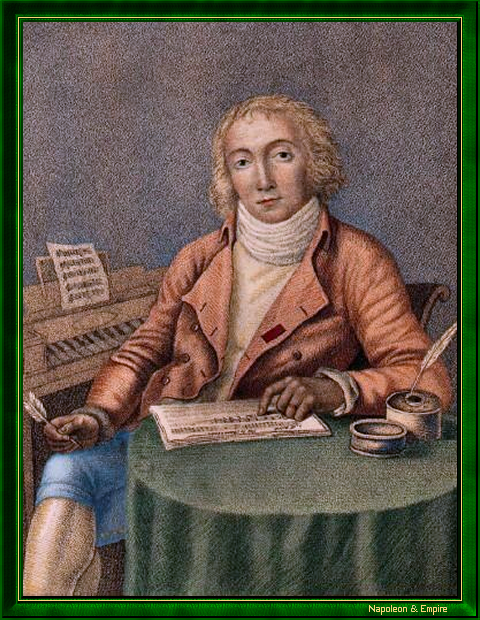Nicolas Marie Dalayrac
Knight of the Empire
Pronunciation:

Nicolas Marie d'Alayrac was born on June 8, 1753 in Muret. His father was Messire Jean d'Alayrac, King's Councillor in Comminges, then second lieutenant to the Count of Artois; his mother was Marie Cluzel.
Young Nicolas was educated in Toulouse. Although destined for the bar, he was more interested in music, and his beginnings as a lawyer were so inconclusive that attempts were made to redirect the young man towards a military career. He became second lieutenant in the guards of the Count of Artois, at Versailles.
Here, D'Alayrac found the opportunity to socialize with musicians - he received advice from André Grétry, and made friends with the Chevalier de Saint-Georges - and wealthy amateurs.
In 1781, after publishing a series of highly successful concertante quartets under an Italianate pseudonym, he had two short comic operas, Le Petit souper and Le Chevalier à la mode, performed at the home of Baron Pierre Victor de Besenval de Brünstatt, one of his acquaintances from the salons. Both pieces pleased the Queen.
The following year, Marie-Antoinette's support enabled him to perform a comedy interspersed with ariettes at the Comédie-italienne (later Opéra-Comique), L'Eclipse totale. This launched his career.
During the Revolution, after "republicanizing" his name to Dalayrac, he produced a number of occasional plays, such as La Prise de Toulon (1794). Like Etienne Méhul and Charles Catel, he also contributed to the Fête de l'Etre-suprême, organized by Maximilien de Robespierre on June 8, 1794. In 1798, the Directoire listed him among the "citizens who have well deserved the Patrie [...] as the author of the operas Le Château de Montenero and Les deux prisonniers".
Dalayrac's greatest successes followed his election to the Stockholm Academy in 1798: Adolphe et Clara in 1799, Maison à vendre in 1800 and Gulistan in 1805. Napoleon I awarded him the Légion d'honneur on July 17, 1804, and made him a chevalier on May 3, 1809. Despite these signs of imperial favor, Dalayrac was never a member of the Institut or employed at the Conservatoire, due to his poor relations with his peers.
Dalayrac died in Paris on November 27, 1809, without having heard his last work, Le Poète et le musicien, composed for the fifth anniversary of the Emperor's coronation. He is buried in the garden of a private house in Fontenay-sous-Bois, his wife having insisted that his tomb should not be next to those of his jealous rivals in the Père-Lachaise cemetery. In 1838, the tomb was transferred to the commune's parish cemetery.
"Nicolas Dalayrac". Watercolor engraving of the 19th century.

Dalayrac produced fifty-six works in his twenty-eight-year career, most of them based on librettos by Monvel and Marsollier.
Freemasonry: Dalayrac was probably initiated between 1774 and 1777. He was a member of the lodge Les Neuf Soeurs (The Nine Sisters), populated by artists and scholars. Some unreliable accounts attribute to him the music composed for Voltaire's initiation and a celebration given by his lodge in honor of Benjamin Franklin. He also belonged to the lodge Parfaite Estime et Société Olympique (Perfect Esteem and Olympic Society), as a musician in the Olympic Society's orchestra.A bust of Dalayrac was placed in the foyer of the Opéra-comique in 1811.
Ludwig van Beethoven owned copies of some of Dalayrac's scores, including Deux Petits Savoyards (1789), considered one of the masterpieces of eighteenth-century sentimental comedy.